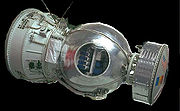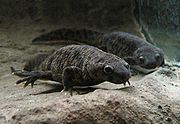
Bion 7
Encyclopedia


Bion (satellite)
The Bion satellites or Bion space program , also named Biocosmos, were a series of Soviet biosatellites. They were part of the Cosmos satellites....
.
It carried two Rhesus monkeys named Gordyy and Oomka, ten male rat
Rat
Rats are various medium-sized, long-tailed rodents of the superfamily Muroidea. "True rats" are members of the genus Rattus, the most important of which to humans are the black rat, Rattus rattus, and the brown rat, Rattus norvegicus...
s, and ten newt
Newt
A newt is an aquatic amphibian of the family Salamandridae, although not all aquatic salamanders are considered newts. Newts are classified in the subfamily Pleurodelinae of the family Salamandridae, and are found in North America, Europe and Asia...
s. The monkey research focused on vestibular and blood flow investigations as well as radiation
Radiation
In physics, radiation is a process in which energetic particles or energetic waves travel through a medium or space. There are two distinct types of radiation; ionizing and non-ionizing...
effects. The newts had part of their front limbs amputated and their crystalline lenses removed to study the possible rate of human recovery from injuries incurred in space. A biocalorimeter monitored energy exchange during the emergence of flies from nymphs; 1500 drosophila
Drosophila
Drosophila is a genus of small flies, belonging to the family Drosophilidae, whose members are often called "fruit flies" or more appropriately pomace flies, vinegar flies, or wine flies, a reference to the characteristic of many species to linger around overripe or rotting fruit...
flies were carried for this purpose. The payload also included maize seeds, crocuses, and guppies in an aquarium. The mission was recovered after seven days.
NSSDC ID: 1985-059A http://nssdc.gsfc.nasa.gov/database/MasterCatalog?sc=1985-059A
Launch Date/Time: 1985-07-10 at 03:15:00 UTC
On-orbit Dry Mass: 5700 kg
Other Names:
- Biocosmos 7
- Cosmos 1667
- 15891
External links
- http://lis.arc.nasa.gov/lis/Programs/Cosmos/Cosmos_1667/Cosmos_1667.html

